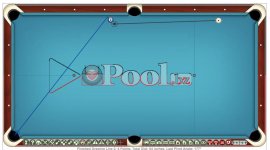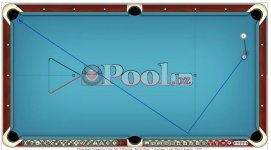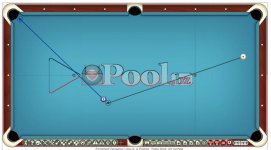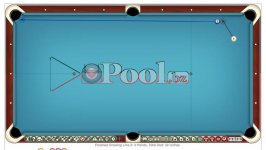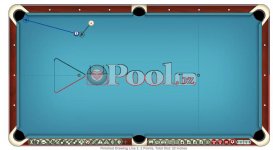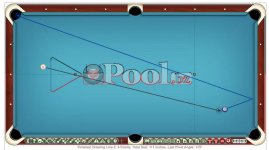I can't sleep and thought of a situation that illustrates how a CTE user gets to the shot line - sort of.
On Thursday in league my opponent was on the 8 ball but only had a scratch shot or some kind of a bank. So he calls a timeout and his teammate comes over and uses a diamond system to figure out the aim for a 3 railer. He tells the guy where to aim and how to hit it. The shooter nails it, high fives all around.
But the shooter had no clue if he was right or wrong. He followed the instructions and since his teammate put him on the right line and he could hit the ball straight it went in three rails.
That's how CTE users are for a lot of shots until they have practiced enough to trust that the line is right.
Many times we follow the instructions - OBJECTIVELY - and take the line we land on with no conscious thought of adjusting in any way from that line. We then focus on the execution just as my opponent did for his three-railer.
I don't think anyone would argue that banking and kicking systems aren't MOSTLY objective when it comes to the aiming. The subjective part I guess would be to know how a table is playing, long, short, slow, fast, etc and adjust for that if needed.
CTE is successfully used for banking. So would one really say that a CTE user who can consistently pocket multi-rail banks like a diamond system can as well is not using an objective system. I mean very consistent results have to point to a higher degree of objectivity in my opinion.
If this was Algebra then both side of the equation have to balance. Going backwards from the pocketed ball through the approach to the table one could simply observe CTE users vs. feel players and see the systematic approach vs. a guessing approach and I feel that the results for the CTE group over a wide range of shots would show a significantly higher success rate.
And that's just for pocketing.
If we were to include near misses to account for execution errors, say if the ball rattles of hits within an inch of the pocket then the success rate would be even higher for the system aimers.
One would expect this result to be true for proficient diamond system users when it comes to banking balls because the diamond systems are mathematically correct on paper. This is accepted that system users do better than feel players.
So when a CTE user has comparable or even higher successful scores over diamond system users then why can't we conclude that CTE aiming must be mostly objective.
John,
To summarize if I may...
Players that use any form of method are more consistent than those players that just guess.
I agree with you that
when a shot fits the visual & the ball pockets it was the true shot line & one COULD say that that shot was pocketed through the use of an objective visual to get to the proper line. Please note the word COULD & understand that it is not universal to every situation.
BUT...when a shot does not fit the objective visual & would NOT pocket the ball through the
objective use of implementing that visual & the ball still pockets...
then the shooter in some way has cheated the system, so to speak, by adding in their own subjective perception of what was needed for the shot... they 'fudged' the 'system' (or the method).
That 'fudging' may have been to get slightly off of the line of the visual, or to modify the pivot, or to steer the cue.
I think you are quite aware of where the issue lays & it's in the questions that I asked you earlier in this thread that you've said you do not know the answers but will work on trying to figure them out.
To say that something is
definitively something & not know the how or why it could be such is, shall we say, disingenuous to a discussion on the topic.
That's the thing, CTEers express their belief with no 'proof' of their belief. Hence the reference to religion by some.
The premise of how CTE would work is intriguing and when it works based off of that premise or method, it is impressive.
But, as has been pointed out by a number of individuals, there are not enough outcome angles possible from the objective visuals to cover all of the needed angles to actually play the game completely successfully.
That is what some have called 'holes' in the supposed system.
So... from your point of view that all shots can be made using the 'system', how can you be correct?
The answer is that the 'hole' shots are made through the interjection of subjective perception (quite most probably subconsciously) in the analysis & subsequent execution of the shot. So... you would then be incorrect to say that the CTE method is 'an objective aiming system'.
I have a couple of times suggested that it might be referred to as a hybrid method that may highly assist one's subjective analyzation & ultimate execution through the use of a visually objective means involving converging visual lines, but that is not as easy or catchy & enticing as 'an objective aiming system', but it is more accurate.
One of the problems when 'discussing' this difference of determination regarding whether or not it is 'an objective aiming system' or of a subjective nature is when some employ different uses of the word 'objective' to suit their intentions & possibly agenda.
If I employ my subjective intuition regarding a shot while using my abilities of spacial & 'visual intelligence' to pocket a shot & have never even ever heard of CTE & the shot pockets then I arrived at the true line for the shot... or said another way, I arrived at the (objectively) true line for the shot.
BUT... I did not use an objective system to do so, or said another way, I did NOT use an objective system to get to the objective (true) line for the shot.
I used a subjective means to arrive at the objective (true) line of the shot.
I think you are on a very good trail toward perhaps properly defining what CTE is & what it's value might or can be for certain individuals if not 'all'.
But, if the 'to the death' cling to the description of 'an objective aiming system' is maintained then the trail will not be a smooth one & you may never arrive at what should be the real true desired destination.
If there is not enough leather to cover a case can you cover the case by just looking at it with a different perception. If you fill in the gaps where there is NOT enough leather by using vinyl, is the case a true leather case. Does 50.0001% of leather qualify one to call it a leather case?
I know this is not an applicable analogy per say, but I am just trying to make a point. Leather & vinyl are hard solid materials while objectivity & subjectivity are of an abstract nature. Hence, they would require different forms of examination to determine their realities. Video can not be used as proof even if it might make some suggestions. The reality of any such suggestions lies in the logical non science bending analysis of them.
I hope this might get us closer to at least a partial agreement of some understanding, but some how I doubt it.
Best Wishes to You & ALL.
